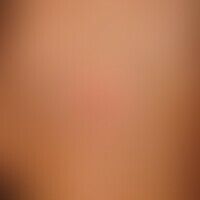T-plastic, bent to reduce defects Images
Go to article T-plastic, bent to reduce defects
T-plasty, curved to reduce the defect. reddish tumor surrounded by a scaly crest, slightly raised above the skin level, with a weeping surface on the back of the hand. tissue sample from the tumor area revealed an invasive squamous cell carcinoma (pT1a; G1). planning of a curved T-plasty to reduce the defect.

T-plasty, bent to reduce the defect; postoperative suture after wedge-shaped tumor excision, reduction of the primary defect by means of a corner suture and transposition of a rotational flap from the back of the hand into the residual defect.

T-plasty, bent to reduce the defect. 5 years after surgery.